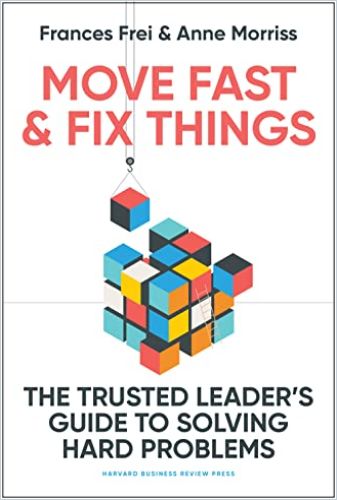Focus on excellence (and fast!) and effective change management.

Productive Change
In its early days, Facebook popularized the evocative phrase “move fast and break things.” This suggests that a company can’t innovate or progress without causing damage, and it implies that progress, by its nature, is destructive. Harvard Business School professor Frances Frei and Leadership Consortium founder Anne Morriss — also the co-authors of Uncommon Service and Unleashed — disagree with that ethos. They argue that great leaders move expeditiously into the future and fix problems as they earn their people’s trust. Speed is good; destruction is not.
Repair things
Good leaders move fast while striving to make repairs. They take responsibility for their customers, employees, investors, and other stakeholders. Thus, the authors say, the appropriate slogan for an innovative 21st-century company is “move fast and fix things.” Leaders must move forward with “accelerating excellence,” constantly raising their company’s value for everyone.
We’ve spent much of the last decade helping companies clean up that wreckage [from ‘break things’] and one of the main lessons from our work is that the trade-off at the heart of this worldview is false.
Francis Frei and Anne Morriss
Frei and Morriss advise assembling a team dedicated to finding and diagnosing the problems your company needs to fix. The crucial word here is “team.” No single person or all-knowing, all-powerful leader can figure out every factor that is holding an organization back. Build your team with people from different positions, levels, and generations who regard the organization with curiosity and empathy.
Gather information relevant to your company’s problems. This data might come from vision statements, investor information, business plans, financial statements, customer surveys, employee engagement surveys, or employee retention records.
Consider every issue from your stakeholders’ point of view. If the company generates only modest profits, for example, shareholders may be frustrated. Customers might be disappointed about a lack of attention or poor product quality. Young employees might be unhappy with the company’s culture and could pursue other opportunities.
Our Fix Map [quadrant is] our take on the requirements for fast, iterative excellence…The map lays out the four potential trajectories of your company: Accelerating Excellence, Responsible Stewardship, Reckless Disruption and Inevitable Decline….where on this framework would you put your own organization? Are you moving fast or slow? Are you building or losing trust?Francis Frei and Anne Morriss
The authors explain that to regain trust, an organization must be authentic and act with integrity. It must always do what it claims it will do, including taking rational, functional approaches to solving stakeholders’ needs.
Your stakeholders want to believe that your company cares about them, so your organizational practices must demonstrate empathy. As you focus on building and reinforcing crucial strengths, the authors caution, respect your employees’ time and don’t neglect or disenfranchise your middle managers.An innovative company needs a culture that conveys necessary information accurately and embraces creativity and innovation.This calls for aligning the different aspects of your organization, such as marketing strategy and day-to-day culture.
Perspectives
Having a diverse, inclusive team enhances stakeholders’ trust.You want to work with people who can approach problems and their solutions from differing points of view.
Frei and Morriss embrace diversity, equity, and inclusion (DEI) as an intrinsic part of organizational strategy because it boosts the company as a whole and benefits people in vulnerable, marginalized groups. Having an inclusive workplace also helps attract and retain talented employees. Promoting more women to senior roles enables your company to address the needs of female clients and stakeholders more effectively. Including more women in the boardroom also improves an organization’s relationship with risk.
Inclusion is the act of creating conditions for other people to thrive, not in spite of their differences as complex, multidimensional humans, but precisely because of those differences.
Francis Frei and Anne Morriss
Inclusion helps company leaders make better decisions because it brings multiple perspectives into their deliberations, and thus improves risk management. Inclusion improves a firm’s efficiency and boosts its revenues. For example, Frei and Morriss report, inclusion increases an organization’s stock price by at least 10%.
Your inclusion plan should include assuring your employees’ psychological safety. Speak to your people or conduct surveys to determine the level of psychological safety they feel. Employees who don’t feel psychologically safe may hesitate to ask questions, contribute ideas, engage with their co-workers, or take on change initiatives. For effective collaboration, your corporate culture must make everyone feel welcome.
A Great Story
Leadership requires storytelling. To lead your organization through change, you must be able to tell the right story about why it needs to change and how it’s going to change. New stories help leaders free their companies from old, damaging stories, such as the idea that breaking things is good.
A change story isn’t only about change; it also should incorporate the elements of your organization you want to preserve.
Start by outlining your company’s positive attributes. Move on to its problems and weak spots. For example, perhaps certain stakeholders have trust concerns and the company needs to rebuild their confidence. Acknowledge any harm the organization has caused and express a firm willingness to confront that harm directly.
The objective of change storytelling is to understand the story deeply enough that you can describe it simply to the people you want to act on that story.
Francis Frei and Anne Morriss
To bring about change, Frei and Morriss say, you must be able to explain why it is necessary and must happen. You might reiterate the problems you identified and outline solutions that require change. Explain how these issues are damaging the organization. How do they limit its future? How can the company repair these flaws?
Outline a clear, actionable, and optimistic way to move forward. And then, tell your organization’s change story to anyone who is willing to listen.
Seize the moment. Many leaders believe that significant change, by its nature, happens slowly. They procrastinate and defer change. Some people delay change by claiming they need more information or that rapid change is reckless and irresponsible. Others suggest they are stretched too thin or their skills are insufficient for a big change.Sometimes the structure of an impending change can create delays. People will always say they need more time to get ready for change, but they are never ready. Promote “move fast and fix things” as a charge everyone can put into action.
Productive Change
Frances Frei and Anne Morris bring proven expertise and an encouraging tone to bear on the never-obsolete question of organizational change. The authors express frustration at the notion that breaking things is the path forward. They fear that younger entrepreneurs especially will fall prey to this limiting notion, and urge all due productive speed instead. Frei and Morriss, always positive and supportive of rapid but thoughtful change, offer detailed strategies for addressing challenges and fomenting, maintaining, and regulating an organization’s progress into the future. Their engaging voice and deep conviction make their advice accessible and practical.














